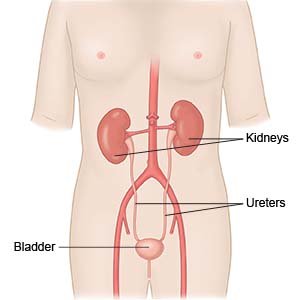Robot Assisted Cystectomy
Medically reviewed by Drugs.com. Last updated on Aug 4, 2025.
What do I need to know about robot assisted cystectomy (RAC)?
RAC is surgery to remove part or all of your bladder through small incisions in your abdomen. RAC is done with a machine that is controlled by your surgeon. The machine has mechanical arms that use small tools to remove your bladder.
 |
How do I prepare for surgery?
- Your surgeon will tell you how to prepare. You may be told not to eat or drink anything after midnight on the day of your surgery. Arrange to have someone drive you home when you are discharged.
- Tell your surgeon about all medicines you currently take. Your surgeon will tell you if you need to stop any medicine for the surgery, and when to stop. Your surgeon will tell you which medicines to take or not take on the day of surgery.
- Tell your surgeon about any allergies you have, including to anesthesia or medicines. You may be given an antibiotic to help prevent a bacterial infection.
- Your surgeon will tell you if you need any tests before your surgery, and when to have them.
Related medications
What will happen during surgery?
You may have a radical (total) or partial cystectomy. Radical means your whole bladder is removed. Your surgeon may also remove nearby lymph nodes and other organs. This includes the prostate and seminal vesicles (glands that produce fluid in semen) in male patients. The uterus, fallopian tubes, and ovaries may also need to be removed in female patients. Partial cystectomy means only the diseased part of your bladder is removed.
- You will be given general anesthesia to keep you asleep and free from pain during surgery. Your surgeon will make several small incisions in your abdomen. Your abdomen will be filled with carbon dioxide to lift the muscles away from your organs. This helps your surgeon see your bladder and nearby organs better.
- Surgical tools are attached to the arms of the robot. Your surgeon will guide the arms to place a laparoscope and other tools inside your abdomen. A laparoscope is a long, thin tube with a light and camera on the end. Your surgeon will then use the arms to remove your bladder through an incision in your abdomen.
- Your surgeon may rebuild or redirect your urinary tract so urine can still drain from your body. A stoma (small opening in your abdomen) may be created so urine can pass through. Your surgeon will then remove the tools from your abdomen. Your incisions will be closed with stitches or medical glue and covered with bandages.
What should I expect after surgery?
- You will be taken to a recovery room until you wake up. Healthcare providers will monitor you for any problems. You will then be taken to your hospital room. You will need to stay in the hospital for at least 1 night. You may need to stay longer depending on your recovery.
- Healthcare providers will teach you how to care for your stoma if one was created. You will also be taught how to drain urine from your body if you are not able to urinate like usual.
What are the risks of RAC?
- You may bleed more than expected or develop an infection or blood clot. Your intestines or nearby organs may be damaged. You may need more surgery to fix this. Your surgeon may need to change the surgery from laparoscopic to open. This means you will need 1 large incision.
- The stoma may become swollen or painful. Part of your intestine may bulge into the area around the stoma. Your urinary tract may leak urine or become blocked and not empty urine. Your intestines may also stop working, and it may become difficult to have a bowel movement. Any of these conditions may become life-threatening.
Care Agreement
You have the right to help plan your care. Learn about your health condition and how it may be treated. Discuss treatment options with your healthcare providers to decide what care you want to receive. You always have the right to refuse treatment. The above information is an educational aid only. It is not intended as medical advice for individual conditions or treatments. Talk to your doctor, nurse or pharmacist before following any medical regimen to see if it is safe and effective for you.© Copyright Merative 2025 Information is for End User's use only and may not be sold, redistributed or otherwise used for commercial purposes.
Further information
Always consult your healthcare provider to ensure the information displayed on this page applies to your personal circumstances.
